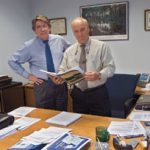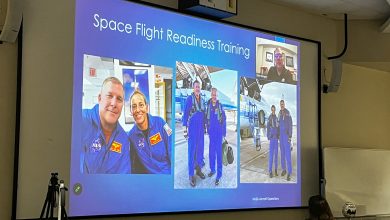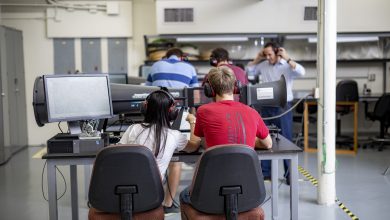Alumni Lead the Charge to Restore Americas Everglades
Ken Ammon ’75 and Tommy Strowd ’76
The Everglades is a nationally significant and unique natural resource. Restoration will improve the quantity and timing of water moving through this vast wetland, allowing recovery of plant and animal communities that were affected by drainage efforts in the last century.
The Everglades is a nationally significant and unique natural resource. Restoration will improve the quantity and timing of water moving through this vast wetland, allowing recovery of plant and animal communities that were affected by drainage efforts in the last century.
Tommy Strowd ’76 (left) and Ken Ammon ’75 started their environmental education in oceanographic technology.
One of the nation’s most significant environmental initiatives—restoration of the Everglades—is under the day-to-day direction of two capable and experienced Florida Institute of Technology graduates.
Ken Ammon ’75 and Tommy Strowd ’76 oversee implementation of the Comprehensive Everglades Restoration Plan (known as CERP), an $8 billion program authorized by Congress in 2000. As executives at the South Florida Water Management District, the lead Florida agency in the state-federal CERP partnership, Ammon, a deputy executive director, and Strowd, assistant deputy, direct the work of more than 400 engineers, hydrologists, land use planners and biologists—as well as dozens of contracted firms—in this monumental restoration effort.
And monumental it is. Everglades wetlands once covered most of South Florida, with seasonal rains flooding thousands of square miles with barely a foot of water. Then less than a century ago, regional drainage canals turned what was viewed as “useless swampland” into usable real estate. Add to that the improved access by railroad and highway, the invention of air conditioning and affordable automobiles plus a thirst for economic growth, and you soon have 8 million people living and working in what was once a virtually uninhabited part of the United States.
That broad perspective is ever-present in the minds of restoration managers. “History has made some decisions that we can’t reverse,” explained Ammon. He cites extensive development west of Ft. Lauderdale, where Everglades wetlands once stretched for miles, as one example. And the fact that the Everglades are now half their original size. “But we can make it better,” Strowd added.
All About the Water
“Making it better” means undoing some of the impacts of regional drainage, without flooding the southern third of the state. Everglades restoration requires capturing large amounts of seasonal rainfall, storing it if needed and then sending it into natural areas, such as Everglades National Park or one of three vast Water Conservation Areas north of the park. The goal is to better match the original, wet- and dry-season flows through these vast wetlands, both in quantity and timing. “Getting the water right” is how it is often described.
Recovery of the ecosystem is expected to follow, and plant and animal communities are being closely monitored for signs of improvement. Early indications are encouraging. For example, the number of wading bird nests, a significant measure of wetland health, is slowly increasing.
But challenges remain, and ecosystem-wide improvements take time. Invasive, non-native plant species have altered the ecology of many natural areas. Water quality issues, particularly the presence of nutrients in stormwater runoff from agricultural fields and urban lawns, threaten to upset the naturally low-nutrient environment of this 3,500-square-mile marsh. And of course people keep moving to South Florida, at a rate of almost 600 a day. Their need for homes and schools and jobs—and water—will keep district water managers busy for many decades to come.
Eye on the Ball
These concerns, while important, are secondary to Ammon and Strowd. Their job is to implement CERP, which includes overseeing all land acquisitions ($1 billion and counting), development of computer modeling on regional hydrology plus the planning, design and construction of numerous restoration projects. It’s a big job.
And it recently got bigger. CERP was originally designed as a broad, 30-year initiative that would move forward at a steady pace. But in the past few years, South Florida’s rising land values, rapidly increasing population and continued pressure for development raised concerns about the original timeline. In October 2004, eight key CERP projects were fast-tracked by Governor Jeb Bush and funded entirely by the state so that benefits could be realized as soon as possible. Nicknamed Acceler8, these projects include reservoirs, stormwater treatment areas and conveyance canals that will provide significant progress toward getting the water right.
Ammon and Strowd together bring almost 70 years of experience to their leadership roles in this effort. Amazingly, neither one has strayed far from where they first began studying the South Florida environment: at Florida Institute of Technology’s Jensen Beach campus, each working on an undergraduate major in oceanographic technology.
They recall studying physics, biology, chemistry and other basic courses but admiringly describe the university’s approach: teaching these subjects using real-world applications with plenty of hands-on work. “I remember testing salinity in 1974 in the Indian River Lagoon,” said Ammon, describing what has recently become a highly contentious public concern about salinity levels in this fragile estuary. The testing, now done on an extensive scale by professional scientists, has become an important part of monitoring the lagoon’s health.
Ammon and Strowd also reminisced about Martin County in the 1970s, when there were few people and even fewer resorts, homes and businesses—or diversions for college students. “There was nothing going west along Jensen Beach Boulevard,” Strowd said, describing a 3-mile county road now lined with shopping centers and residential developments, “until you got to Route 1, where the Treasure Coast Mall is today. There was just a little wooden liquor store there.”
“On the west side of the road,” added Ammon. Strowd nods.
An Effective Partnership
A good memory and eye for detail have served both of them well. Each day brings demands for their attention to issues ranging from technical design of water storage reservoirs and construction of pump stations to public workshops and policy discussions with government officials.
In his role as deputy executive director, Ammon, a licensed professional engineer, handles many of the overview issues, including dialogue with the White House’s Council on Environmental Quality, the U.S. Army Corps of Engineers and other federal and state agencies. Strowd, also a P.E., is his second in command and is instrumental in keeping the many projects and all their details on track.
Their teamwork stretches back almost 30 years. In 1979, Strowd joined the engineering firm of Gee and Jenson, where his fellow alumnus was employed. Had they met before? Ammon shakes his head no.
“I knew who Ken was for two reasons,” said Strowd immediately. “He was a year or two ahead of me at FIT and was known for his senior thesis project that actually had funding. He and two classmates had received a grant from some corporation. They had a lab and everything. We were incredibly impressed.
“The other reason was that he had worked every problem in this big, thick calculus book we had. Whenever any of us challenged an answer or complained to the teacher about an impossible problem, he would pull out a thick folder and show us exactly how it was done. The work was all Ken’s.”
Silently, Ammon gets up, walks over to a bookshelf near his desk and brings back a very battered textbook. Sure enough, it’s Calculus and Analytic Geometry, 4th edition, by George B. Thomas, Jr., copyright 1969. The spine is broken, and the cover is filthy. Strowd laughs, “That’s it! That’s the book.”
So it should come as no surprise that these two grads are entrusted with implementing a complex, $8 billion environmental restoration program. Their teamwork, upbeat attitude, professionalism and focus on success are easy to recognize. They think big but get the details right. It’s an impressive combination.
Barbara Ross
Senior Writer,
South Florida Water Management District
All photos courtesy SFWMD– Patrick Lynch, photographer






